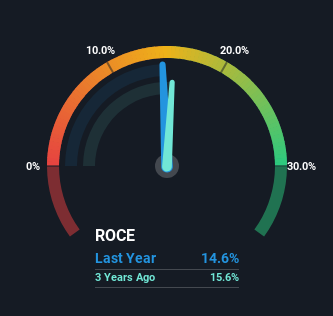- Canada
- /
- Food and Staples Retail
- /
- TSX:ATD
Slowing Rates Of Return At Alimentation Couche-Tard (TSE:ATD) Leave Little Room For Excitement

There are a few key trends to look for if we want to identify the next multi-bagger. Typically, we'll want to notice a trend of growing return on capital employed (ROCE) and alongside that, an expanding base of capital employed. Basically this means that a company has profitable initiatives that it can continue to reinvest in, which is a trait of a compounding machine. With that in mind, the ROCE of Alimentation Couche-Tard (TSE:ATD) looks decent, right now, so lets see what the trend of returns can tell us.
Understanding Return On Capital Employed (ROCE)
For those who don't know, ROCE is a measure of a company's yearly pre-tax profit (its return), relative to the capital employed in the business. Analysts use this formula to calculate it for Alimentation Couche-Tard:
Return on Capital Employed = Earnings Before Interest and Tax (EBIT) ÷ (Total Assets - Current Liabilities)
0.15 = US$4.1b ÷ (US$36b - US$8.2b) (Based on the trailing twelve months to February 2024).
Thus, Alimentation Couche-Tard has an ROCE of 15%. In absolute terms, that's a satisfactory return, but compared to the Consumer Retailing industry average of 12% it's much better.
Check out our latest analysis for Alimentation Couche-Tard

Above you can see how the current ROCE for Alimentation Couche-Tard compares to its prior returns on capital, but there's only so much you can tell from the past. If you're interested, you can view the analysts predictions in our free analyst report for Alimentation Couche-Tard .
What Can We Tell From Alimentation Couche-Tard's ROCE Trend?
The trend of ROCE doesn't stand out much, but returns on a whole are decent. Over the past five years, ROCE has remained relatively flat at around 15% and the business has deployed 62% more capital into its operations. 15% is a pretty standard return, and it provides some comfort knowing that Alimentation Couche-Tard has consistently earned this amount. Stable returns in this ballpark can be unexciting, but if they can be maintained over the long run, they often provide nice rewards to shareholders.
The Bottom Line
In the end, Alimentation Couche-Tard has proven its ability to adequately reinvest capital at good rates of return. Therefore it's no surprise that shareholders have earned a respectable 91% return if they held over the last five years. So while the positive underlying trends may be accounted for by investors, we still think this stock is worth looking into further.
Like most companies, Alimentation Couche-Tard does come with some risks, and we've found 2 warning signs that you should be aware of.
While Alimentation Couche-Tard isn't earning the highest return, check out this free list of companies that are earning high returns on equity with solid balance sheets.
New: Manage All Your Stock Portfolios in One Place
We've created the ultimate portfolio companion for stock investors, and it's free.
• Connect an unlimited number of Portfolios and see your total in one currency
• Be alerted to new Warning Signs or Risks via email or mobile
• Track the Fair Value of your stocks
Have feedback on this article? Concerned about the content? Get in touch with us directly. Alternatively, email editorial-team (at) simplywallst.com.
This article by Simply Wall St is general in nature. We provide commentary based on historical data and analyst forecasts only using an unbiased methodology and our articles are not intended to be financial advice. It does not constitute a recommendation to buy or sell any stock, and does not take account of your objectives, or your financial situation. We aim to bring you long-term focused analysis driven by fundamental data. Note that our analysis may not factor in the latest price-sensitive company announcements or qualitative material. Simply Wall St has no position in any stocks mentioned.
About TSX:ATD
Alimentation Couche-Tard
Operates and licenses convenience stores in North America, Europe, and Asia.
Very undervalued second-rate dividend payer.
Similar Companies
Market Insights
Community Narratives




